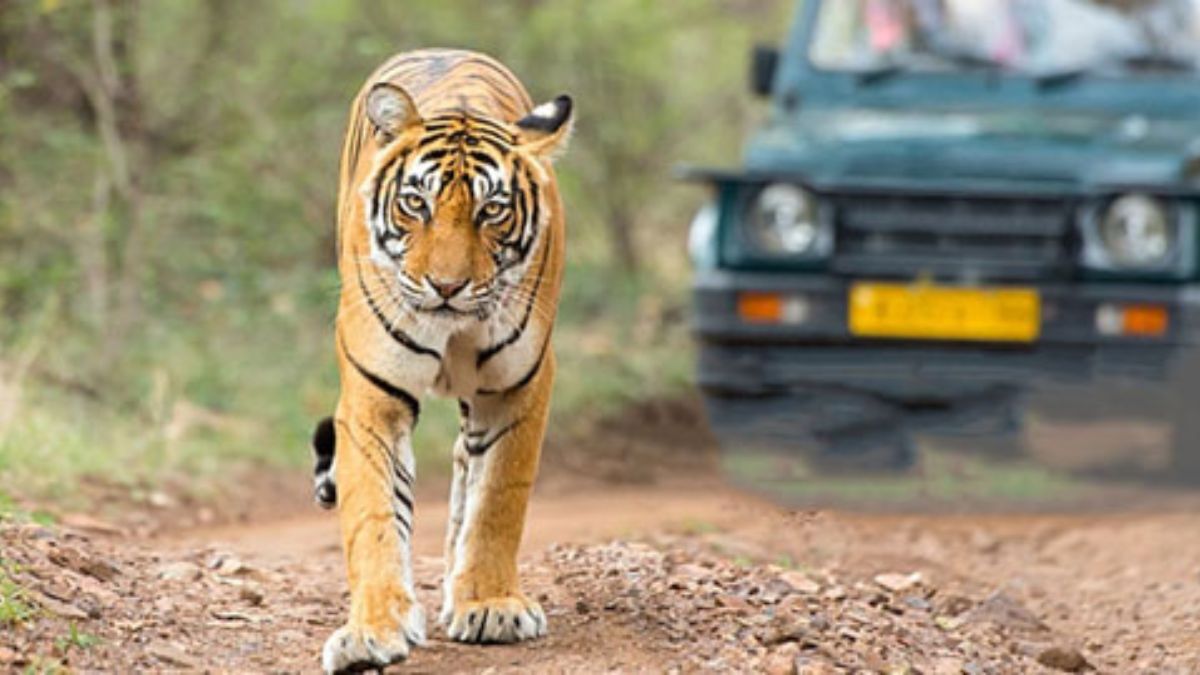The Supreme Court has banned tiger safaris in the core areas of the Jim Corbett National Park in Uttarakhand, ruling that it can be allowed in buffer zones. The apex court also rapped the Uttarakhand government for the illegal construction and felling of trees at the Corbett tiger reserve, reportedly calling it a “classic case” of the “unholy” nexus between politicians and bureaucrats.
A three-judge Bench comprising Justices BR Gavai, PK Mishra and Sandeep Mehta also directed the Environment Ministry to form a committee to examine whether tiger safaris should be allowed in the buffer or fringe areas of a tiger reserve, citing the employment it brings.
Let’s take a closer look.
SC’s rebuke over deforestation at Corbett
The top court came down heavily on former Uttarakhand forest minister Harak Singh Rawat and ex-divisional forest officer Kishan Chand for allowing illegal felling of over 6,000 trees to construct buildings “under the pretext of promotion of tourism” at the Corbett national park.
Remarking on the “huge devastation” caused by the felling of trees, the bench said it was “amazed at the audacity” of the duo for disregarding forest and wildlife conservation laws and throwing the public trust doctrine “into the dustbin”, The Hindu reported.
Noting a Central Bureau of Investigation (CBI) probe is already underway, the court said Uttarakhand could not “run away” from its responsibility to “restore the damage done to the forest”.
“Apart from preventing such acts in the future, the State must take immediate steps for the restoration of the damage. It has to undertake an exercise to determine the valuation of the damage done and recover it from the persons found responsible,” the three-judge Bench said in the verdict, as per Livelaw.
Impact Shorts
More ShortsThe top court also directed the CBI to submit a report on its investigation within three months.
What did SC say on tiger safaris?
Beginning the announcement of the verdict with a quote from the epic Mahabharata, Justice Gavai reportedly said, “The tiger perishes without the forest, and the forest perishes without its tigers. Therefore, the tigers should stand guard over the forest and the forests should protect all its tigers.”
The bench was hearing a petition by environment activist and lawyer Gaurav Bansal challenging the Uttarakhand government’s proposal for a tiger safari and a zoo with caged animals inside the Jim Corbett National Park.
“The presence of tigers in the forests is an indicator of the well-being of the ecosystem. Unless steps are taken for the protection of tigers, the ecosystem which revolves around tigers cannot be protected… Events like illegal construction and illicit felling of trees like the one in Corbett cannot be ignored,” Justice Gavai noted in the judgement, as per The Hindu report.
The top court said that tiger safaris that “already exist and the one under construction at Pakhrau (falling in the fringe area of the Corbett National Park) will not be disturbed”.
“However, insofar as the safari at Pakhrau is concerned, we direct that the State of Uttarakhand to relocate or establish a rescue centre in the vicinity of the ‘Tiger Safari’,” it noted in its judgement.
The court said the panel to be appointed by the Environment Ministry will have representatives of the NTCA, the Wildlife Institute of India (WII), the Central Empowered Committee (CEC), and an officer from the ministry, not below the rank of joint secretary, as its member secretary.
This specialised committee will analyse and recommend “as to whether Tiger Safaris shall be permitted in the buffer area or fringe area’ and “if such Safaris can be permitted, then what should be the guidelines for establishing such Safaris?”
The panel would also assess damage done to the Corbett reserve’s forest cover and recover the cost from the culprits.
The apex court said the committee will “recommend the measures for restoration of the damages, in the local in situ environment to its original state before the damage was caused…assess the environmental damage caused in the Corbett Tiger Reserve (CTR) and quantify the costs for restoration…identify the persons/officials responsible for such damage. Needless to state, the State shall recover the cost so quantified from the persons/delinquent officers found responsible for the same…” and “specify how the funds so collected be utilised for active restoration of ecological damage”, reported Indian Express.
The apex court also raised objections to the NTCA’s 2019 guidelines allowing tigers exhibited in zoos for these safaris. Referring to Section 9 of the 2016 NTCA guidelines, Justice Gavai said that only injured tigers after suitable treatment, conflict tigers or orphaned tiger cubs within reserves should be displayed in safaris.
“The approach must be of eco-centrism and not of anthropocentrism. The precautionary principle must be applied to ensure that the least amount of environmental damage is caused. The animals sourced shall not be from outside the tiger reserve,” the bench observed in its verdict.
With inputs from agencies
)